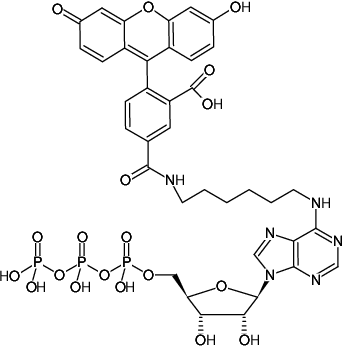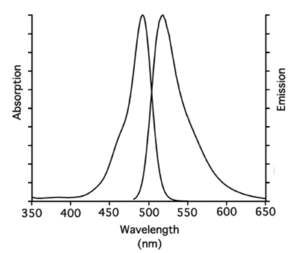N6-(6-Aminohexyl)-adenosine-5'-triphosphate, labeled with 5 FAM, Triethylammonium salt
| Cat. No. | Amount | Price (EUR) | Buy / Note |
|---|---|---|---|
| NU-805-5FM | 40 μl (1 mM) | 274,70 | Add to Basket/Quote Add to Notepad |


For general laboratory use.
Shipping: shipped on gel packs
Storage Conditions: store at -20 °C
Short term exposure (up to 1 week cumulative) to ambient temperature possible.
Shelf Life: 12 months after date of delivery
Molecular Formula: C37H39N6O19P3 (free acid)
Molecular Weight: 964.66 g/mol (free acid)
Exact Mass: 964.15 g/mol (free acid)
Purity: ≥ 95 % (HPLC)
Form: solution in water
Color: yellow
Concentration: 1.0 mM - 1.1 mM
pH: 7.5 ±0.5
Spectroscopic Properties: λexc 492 nm, λem 517 nm, ε 83.0 L mmol-1 cm-1 (Tris-HCl pH 7.5)
BIOZ Product Citations:
Selected References:
Rauch et al. (2017) BAG3 Is a Modular, Scaffolding Protein that physically Links Heat Shock Protein 70 (Hsp70) to the Small Heat Shock Proteins. J. Mol. Biol. 429 (1):128.
Assimon et al. (2015) Specific Binding of Tetratricopeptide Repeat Proteins to Heat Shock Protein 70 (Hsp70) and Heat Shock Protein 90 (Hsp90) Is Regulated by Affinity and Phosphorylation. Biochemistry. 54 (48):7120.
Evans et al. (2015) Investigating Apoptozole as a Chemical Probe for HSP70 Inhibition. PLoS One. 10 (10):e0140006.
Lewallen et al. (2012) Probing adenylation: using a fluorescently labelled ATP probe to directly label and immunoprecipitate VopS substrates. Mol. Biosyst. 8 (6):1701.
Massey et al. (2010) A novel, small molecule inhibitor of Hsc70/Hsp70 potentiates Hsp90 inhibitor induced apoptosis in HCT116 colon carcinoma cells. Cancer Chemother. Pharmacol. 66 (3):535.
Williamson et al. (2009) Novel adenosine-derived inhibitors of 70 kDa heat shock protein, discovered through structure-based design. J. Med. Chem. 52 (6):1510.